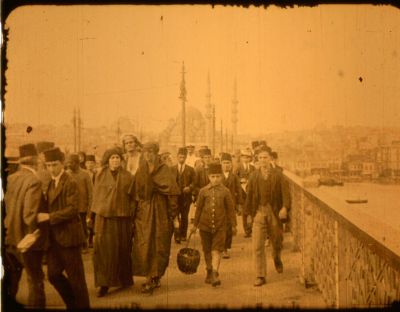
VEDUTE DALL'IMPERO OTTOMANO 1896-1914 / 3
Territori, confini e colonialismo
TURKEY - KONSTANTINOPEL
(Francia/1909-1913?) Prod.: Pathé Freres - La Milanese. 35mm. L.: 129 m. D.: 7' a 17 f/s. Pochoir / Stencil. Didascalie tedesche / German intertitles. Da: Filmarchiv Austria
SMYRNE
(Francia/1911). Prod.: Éclair. 35mm. L.: 40 m. D.: 2' a 17 f/s. Bn. Da: EYE Filmmuseum
ANI. LA CITTA DALLE MILLE CHIESE
(Italia/1911) Prod.: S.A. Ambrosio. L.: 100 m. D.: 5' a 17 f/s. Bn. Da: BFI - National Archive
TURKIJE
[Francia/1915?] Prod.: Radios - Eclipse. 35mm. L.: 105 m. D.: 5' a 18 f/s. Imbibito / Tinted. Didascalie olandesi / Dutch intertitles. Da: EYE Filmmuseum
CHEZ LES BOSNIAQUES
(Francia/1912) 35mm. L.: 98 m. D.: 5' a 18 f/s. Bn. Da: CNC - Archives Françaises du Film
TUNIS AND SURROUNDINGS
(GB/1912) Prod.: Urbanora. 35mm. L.: 120 m. D.: 6' a 18 f/s. Bn. Didascalie inglesi / English intertitles. Da: BFI - National Archive
CONSTANTINE
(Francia/1913)Prod.: Éclair Scientia. 35mm. L.: 122 m. D.: 6' a 18 f/s. Imbibito e virato / Tinted and toned. Didascalie olandesi / Dutch intertitles. Da: : EYE Filmmuseum (The Desmet Collection)
BLUME DER KASBA
(Italia/1905?) Prod.: Ambrosio. 35mm. L.: 10 m. D.: 30" a 16 f/s. Bn. Da: BFI - National Archive
TRA LE PINETE DI RODI
(Italia/1912) Prod.: Savoia. 35mm. L.: 100 m. D.: 5' a 18 f/s. Imbibito, pochoir / Tinted, stencil. Da: EYE Filmmuseum
EGYPT AND HER DEFENDERS
(GB/1914) Prod.: Kineto. 35mm. L.: 210 m. D.: 10' a 18 f/s. Bn. Didascalie inglesi / English intertitles. Da: BFI - National Archive
VUES LUMIÈRE: NO. 409 NO. 416: BETHLÉEM-BEYROUTHDAMAS-CONSTANTINOPLE
(Francia/1897) F: Alexandre Promio. Prod.: Lumière. 35mm. L.: 210 m. D.: 11' a 18 f/s. Bn. Da: Institut Lumière, Lyon
AEGYPTEN - ALEXANDRIEN - KAIRO
[1915?] DCP. D.: 5'. Bn.Da: Deutsche Kinemathek. Restaurato nel 2014 da / Restored in 2014 by Fondazione Cineteca di Bologna a partire di un nitrato da / from a nitrate print of Deutsche Kinemathek
Accompagnamento al piano di Neil Brand
Nel 1683, al momento della sua massima estensione, l'Impero ottomano andava dall'Ungheria e Crimea a Nord al Corno d'Africa a Sud, dal mar Caspio e Golfo Persico a Est al confine marocchino a Ovest. Nel 1914 l'Impero comprendeva ancora i territori dell'Asia Minore, la Siria, la Palestina e l'Iraq, e gran parte della Penisola Arabica. Cercando di mettere insieme un programma che presentasse un Grand Tour dell'Impero ottomano, dalla Bosnia al Maghreb, con Costantinopoli al centro, abbiamo dovuto fare i conti con il fatto che molti dei film del periodo 1896-1914 sono stati girati in regioni che non facevano più parte dell'Impero, come Algeria e Tunisia (occupate dalla Francia rispettivamente nel 1830 e 1881), o ne facevano parte solo nominalmente, come l'Egitto (dal 1882 controllato dalla Gran Bretagna). E dunque legittimo usare l'Impero ottomano come una matrice, come una chiave d'accesso per recuperare un corpus di film alla visione e alla ricerca? O invece il nostro approccio e una (speriamo produttiva) falsa partenza? Il cinema delle origini era un'industria internazionale, e i grandi produttori francesi come Pathe, che rifornivano tutti i mercati e i clienti, facevano attenzione a mantenere una posizione politica neutrale. Gli italiani, dopo essersi annessi la Libia nel 1911 e Rodi nel 1912, realizzarono invece film dal forte contenuto nazionalista e colonialista, mentre gli inglesi (vedi Egypt and Her Defenders, 1914) usarono il cinema come mezzo di propaganza antiturca. Il nazionalismo non solo frantumo gli imperi multinazionali dell'Impero ottomano e austro-ungarico; accelero anche la fine di ciò che appare, a posteriori, come l'origine utopica del cinema, il nuovo mass medium capace di connettere i pubblici di tutto il mondo in un'esperienza condivisa.
Mariann Lewinsky
In 1683, the moment of its greatest extent, the Ottoman Empire stretched from most of Hungary and the Crimea in the North, to the Caspian Sea and the Persian Gulf in the East, the Horn of Africa in the South, and to the border of Morocco in the West. In 1914 the Empire still covered Asia Minor, Syria, Palestine, and Iraq, and the greater part of the Arabian Peninsula. Filming started in 1896, and while trying to put together a programme presenting a Grand Tour of the Ottoman Empire, from Bosnia to the Maghreb, with Constantinople at its centre, we realized that many extant films from 1896-1914 were shot in regions then no longer part of the Ottoman Empire, such as Algeria and Tunisia (occupied by France in 1830 and 1881 respectively), or only nominally Ottoman, such as Egypt (controlled by Britain since 1882). So, is it now legitimate to use the Ottoman Empire as a matrix, as a key of access to retrieve a corpus of films for viewing and for research? Or was our approach a (hopefully productive) false start? Early cinema was an international export business, and the great French producers such as Pathe who catered to all markets and clients took care to keep a politically neutral stance. The Italians, however, after having seized Libya in 1911 and Rhodes in 1912, made films with a strong nationalist and colonialist agenda, while the British (see Egypt and Her Defenders, 1914) used film as a means of anti-Turkish propaganda. Nationalism not only split up the multinational realms of the Ottoman and the Austro-Hungarian empires; it also brought about the end of what appears, in hindsight, as the utopian beginnings of cinema, the new mass medium that connected audiences all over the world in a shared experience.
Mariann Lewinsky

Tariffe:

Numero posti: 174
Aria Condizionata
Accesso e servizi per disabili
Il nostro cinema aderisce al circuito CinemAmico: è possibile utilizzare l’applicazione MovieReading® per i film di cui è prevista audiodescrizione e/o sottotitolazione sull'applicazione.
Tel. 051 2195311










